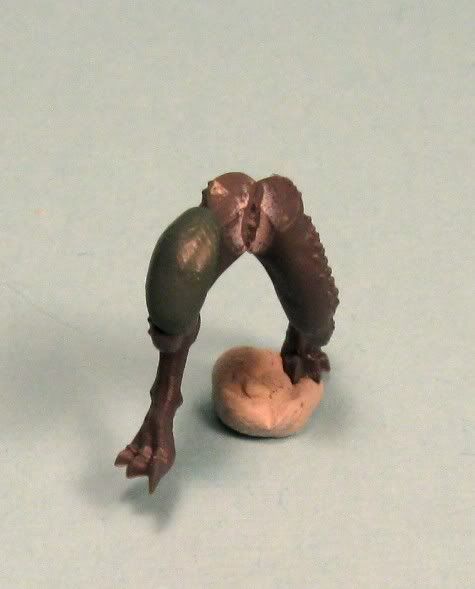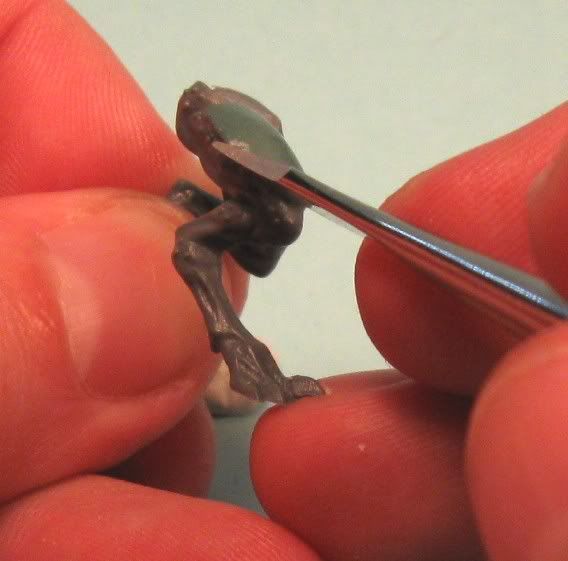Armor Plating
Tools Used: Xacto knife, various metal sculpting tools, tooth picks, needles, colour shapers (primarily Royal Sovereign Size 0, for beginners I recommend the Firm), Ball Burnisher/Stylus, Mechanical Pencil, Thin Wall Metal Tubing
The picture below shows the various tools I use:
 1 – Large Spoon Spatula
1 – Large Spoon Spatula: I use this for smoothing larger plate areas. Turned on
its edge works great for smoothing out the edges of your plates.
2 – Firm Round taper point. I use this for getting into all of those really tight areas and for smooth curved concave surfaces.
3 – Cup Round. I use this one for general smoothing. Flat for smoothing plates and convex surfaces. Round for concave surfaces and for round raised edges.
4 – Ball Burnisher / Stylus. I use this primarily for chainmail, but also for make holes in putty plates. Has too ball sizes. I also use this for denting and making the ball-peened hammer type look on the plates.
5 – Flat Chisel. General Smoothing. Square raised edges. Smoothing out plate edges.
6 – Metal Tooth Pick Hook. The point is like the Stylus. The bend kind of works like the Round Taper and Cup Round, but much finer than both and moves the putty much better.
7 – Mechanical Pencil. Used for recessed rivets and normal rivets when coupled with an xacto.
8 – Cup Chisel, Soft. When you really need a soft touch. These are the work horses for the way I make the raised edges on the armor.
9 – Cup Chisel, Firm. When you can use a slightly firmer touch. These are the work horses for the way I make the raised edges on the armor.
a – Knife on one end and long narrow spoon of uniform width.
b - Normal style knife, spoon spatula Sculpting tool. When you need to really move the putty. These are the work horses for the way I make the raised edges on the armor. The knife end used for smoothing the edges of the plates.
c - Normal style knife, spoon spatula Sculpting tool, but larger than b.
Materials Used: Brownstuff (
BS), or Greenstuff (
GS), Water.
General Notes, The More Common Putties
Greenstuff (also known as Kneadatite Blue-Yellow)
It is the most common putty you see used. It will cure solid, but will retain some flexibility. Very similar to a hard rubber. It strength is that it is excellent for making organic shapes. Its weakness is that it does not hold well for sharp edges. If you want really sharp edges, use your Xacto Knife and cut those edges after the
GS has cured.
GS can easily be cut once cured.
GS does not take well to sanding or filing, but that does not mean you cannot smooth it out after it has cured. To smooth it after it is cured, use a sharp razor blade and gently shave the
GS with the edge of the blade. Holds detail very well. Semi-sticky like gum in the early stages of curing, after being mixed.
Brownstuff (also known as Kneadatite Brown-Aluminum)
BS is a hard putty that combines a bit of flexibility with the ability to be sanded and filed into sharp edges. It cures harder than
GS, and is more brittle.
BS is often used for making mechanical looking parts or other metal parts like sword blades. I have also found that
BS is much easier to get smooth before its cured than
GS. Does not work as well as
GS when sculpting more organic looking stuff, better suited for mechanical things.
Apoxie-Sculp
Apoxie-sculp is a self-hardening synthetic clay that combines the features and benefits of clay with those of epoxy. Apoxie sculp will be very soft when mixed, and has a much longer working time than
BS or
GS and takes a couple hours to really start stiffening. Once cured it becomes rock like. It can take sanding and filing. Its very strong and rigid. However, it does not take detail very well in my opinion.
Milliput
Milliput is an epoxy putty that cures hard. Once fully cured Milliput can be machined, drilled, tapped, turned, filed, sawn, sanded, but can be brittle.
Putty Mixing / Curing
After mixing the
GS or
BS putty, it will be soft and pliable. You will have about 20-30 minutes where it is very soft. This is a good time for basic shapes. After the first 20 minutes the putty will start showing more rubbery characteristics and begin to harden. Most epoxy putties, also depends on the amount of the hardener you use, will have about 1-1.5 hours of working time before it is too hard to work anymore. Epoxy putty will typically cure fully in about 24 hours.
General Tips for Armor Plates
- Recommend using
BS, but
GS works fine.
BS is more forgiving in getting smooth plates, especially if you are new to using putty.
- Sharp edges are very critical to make it look right.
- To make raised edges very gently use your spatula/spoon tool, ball burnisher, or my personal favorites the chisel pointed colour shapers.
- For recessed rivets use a mechanical pencil without the lead in them and simply jab the putty as it's curing with the metal tubing.
- Plastic Rod Rivet method. Use your Xacto to shave off a thin layer of plastic rod. Place a tiny drop of glue on the model where you want the rivet and put the thin layer of the plastic rod over the glue.
- For raised rivets, allow the putty armor to cure (it helps if you put a little tiny divot in the putty where the rivet is going), flatten a small ball of putty over the armor, then use the tubing and press it into the flattened piece of putt. Remove the excess putty and allow it to cure. This is a very delicate rivet, not durable at all unless it is sealed in place somehow. I recommend the recessed rivet for use with your armies and things that get played with, its much more durable and gets the idea across easily.
Automatically Appended Next Post: Alright, let’s do some armor plates. Here we have a set of bloodletter legs, I’ve added a sheet of
GS to the legs in the general shape that I want on the leg, and smoothed it out with my fingers. Again use water and/or lotion on your fingers to smooth out the
GS.

Next shape up the armor plate edges with the knife end of your sculpting tool. Done right this will give you a fairly sharp edge.

Smooth out the plate. In this picture you see me using the round cup smoothing out the
GS. This is a cool picture, as you can actually see the water between the cup and the
GS, as I was lifting the tool to back up and smooth an area out.

You could also use the spoon/spatula shaped end of your sculpting tool to do this, like what I am doing on this arm.

At this point I want to make the plate on the leg into several plates, so I’m using the firm flat chisel point to make raised edges for what will be overlapping plates.

Now back to the arm. I’m not making a number of plates, but I am using the same technique to make raised edges around the perimeter of the plate. In this picture I am gently denting the plate with the cup chisel. I do this by pushing edge in and then gently drag it back to smooth the central area. Again we are doing this after we got the plate completely smooth and the edge defined.

Some more coming up very soon.
---PPC
Automatically Appended Next Post:
Some additional pics of the arm:

